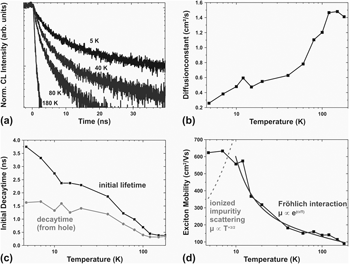Crossref Citations
This article has been cited by the following publications. This list is generated based on data provided by
Crossref.
Juday, R.
M. Silva, E.
Y. Huang, J.
G. Caldas, P.
Prioli, R.
and
Ponce, F. A.
2013.
Strain-related optical properties of ZnO crystals due to nanoindentation on various surface orientations.
Journal of Applied Physics,
Vol. 113,
Issue. 18,
Chia, Chin-Hau
and
Yen, Ming-Hsiu
2014.
Radiative efficiency of inelastic exciton-exciton scattering in ZnO nanocrystalline films.
Optical Materials Express,
Vol. 4,
Issue. 5,
p.
1023.
Cammi, Davide
Röder, Robert
and
Ronning, Carsten
2014.
Gate modulation of below-band-gap photoconductivity in ZnO nanowire field-effect-transistors.
Journal of Physics D: Applied Physics,
Vol. 47,
Issue. 39,
p.
394014.
Wu, Bin
Zhang, Yuantao
Shi, Zhifeng
Li, Xiang
Cui, Xijun
Zhuang, Shiwei
Zhang, Baolin
and
Du, Guotong
2014.
Different defect levels configurations between double layers of nanorods and film in ZnO grown on c-Al2O3 by MOCVD.
Journal of Luminescence,
Vol. 154,
Issue. ,
p.
587.
Polyakov, A. N.
Stepovich, M. A.
and
Turtin, D. V.
2015.
Three-dimensional diffusion of excitons generated by an electron beam in a semiconductor material: Results of mathematical modeling.
Journal of Surface Investigation. X-ray, Synchrotron and Neutron Techniques,
Vol. 9,
Issue. 6,
p.
1251.
Kuznetsova, Y. Y.
Fedichkin, F.
Andreakou, P.
Calman, E. V.
Butov, L. V.
Lefebvre, P.
Bretagnon, T.
Guillet, T.
Vladimirova, M.
Morhain, C.
and
Chauveau, J.-M.
2015.
Transport of indirect excitons in ZnO quantum wells.
Optics Letters,
Vol. 40,
Issue. 15,
p.
3667.
Polyakov, A. N.
Stepovich, M. A.
and
Turtin, D. V.
2016.
Mathematical modeling of the cathodoluminescence of excitons generated by a narrow electron beam in a semiconductor material.
Bulletin of the Russian Academy of Sciences: Physics,
Vol. 80,
Issue. 12,
p.
1436.
Donatini, F.
de Luna Bugallo, Andres
Tchoulfian, Pierre
Chicot, Gauthier
Sartel, Corinne
Sallet, Vincent
and
Pernot, Julien
2016.
Comparison of Three E-Beam Techniques for Electric Field Imaging and Carrier Diffusion Length Measurement on the Same Nanowires.
Nano Letters,
Vol. 16,
Issue. 5,
p.
2938.
Polyakov, A. N.
Stepovich, M. A.
and
Turtin, D. V.
2016.
Cathodoluminescence studies of exciton diffusion in gallium nitride.
Journal of Surface Investigation. X-ray, Synchrotron and Neutron Techniques,
Vol. 10,
Issue. 3,
p.
563.
Donatini, Fabrice
Sartel, Corinne
Sallet, Vincent
and
Pernot, Julien
2017.
Electron beam dose dependence of surface recombination velocity and surface space charge in semiconductor nanowires.
Nanotechnology,
Vol. 28,
Issue. 23,
p.
235701.
Sakr, G
Sartel, C
Sallet, V
Lusson, A
Patriarche, G
Galtier, P
and
Barjon, J
2017.
Surface effects on exciton diffusion in non polar ZnO/ZnMgO heterostructures.
Journal of Physics: Condensed Matter,
Vol. 29,
Issue. 48,
p.
485706.
Maiberg, Matthias
Bertram, Frank
Müller, Mathias
and
Scheer, Roland
2017.
Theoretical study of time-resolved luminescence in semiconductors. IV. Lateral inhomogeneities.
Journal of Applied Physics,
Vol. 121,
Issue. 8,
Donatini, Fabrice
and
Pernot, Julien
2018.
Exciton diffusion coefficient measurement in ZnO nanowires under electron beam irradiation.
Nanotechnology,
Vol. 29,
Issue. 10,
p.
105703.
Stepovich, Mikhail A.
Turtin, Dmitry V.
Seregina, Elena V.
Kalmanovich, Veronika V.
and
Yermolov, P.
2019.
On the correctness of mathematical models of time-of-flight cathodoluminescence of direct-gap semiconductors.
ITM Web of Conferences,
Vol. 30,
Issue. ,
p.
07014.
Zhou, N.
Hu, B. C.
Zhang, Q. Y.
Ma, C. Y.
and
Hao, S. Z.
2019.
Theoretical model of excitonic luminescence and its application to the study of fine structure and exciton dynamics in ZnO.
Journal of Applied Physics,
Vol. 126,
Issue. 16,
Fiedler, Saskia
Lee Cheong Lem, Laurent O.
Ton-That, Cuong
and
Phillips, Matthew R.
2020.
The role of surface depletion layer effects on the enhancement of the UV emission in ZnO induced by a nanostructured Al surface coating.
Applied Surface Science,
Vol. 504,
Issue. ,
p.
144409.
Vásquez, G. C.
Johansen, K. M.
Galeckas, A.
Vines, L.
and
Svensson, B. G.
2020.
Optical signatures of single ion tracks in ZnO.
Nanoscale Advances,
Vol. 2,
Issue. 2,
p.
724.
Sedlak, Jakub
Kuritka, Ivo
Masar, Milan
Machovsky, Michal
Urbanek, Pavel
Bazant, Pavel
Janota, Pavel
and
Dvorackova, Marie
2020.
Contributions of morphological and structural parameters at different hierarchical morphology levels to photocatalytic activity of mesoporous nanostructured ZnO.
Applied Surface Science,
Vol. 513,
Issue. ,
p.
145773.
Степович, Михаил Адольфович
Stepovich, Mikhail Adolfovich
Туртин, Д В
Turtin, D V
Серегина, Елена Владимировна
and
Seregina, Elena Vladimirovna
2021.
О корректности математических моделей диффузии, обусловленной остро сфокусированным электронным зондом в однородном полупроводниковом материале.
Итоги науки и техники. Серия «Современная математика и ее приложения. Тематические обзоры»,
Vol. 193,
Issue. ,
p.
122.
Brandt, Oliver
Kaganer, Vladimir M.
Lähnemann, Jonas
Flissikowski, Timur
Pfüller, Carsten
Sabelfeld, Karl K.
Kireeva, Anastasya E.
Chèze, Caroline
Calarco, Raffaella
Grahn, Holger T.
and
Jahn, Uwe
2022.
Carrier Diffusion in
GaN
: A Cathodoluminescence Study. II. Ambipolar versus Exciton Diffusion.
Physical Review Applied,
Vol. 17,
Issue. 2,



